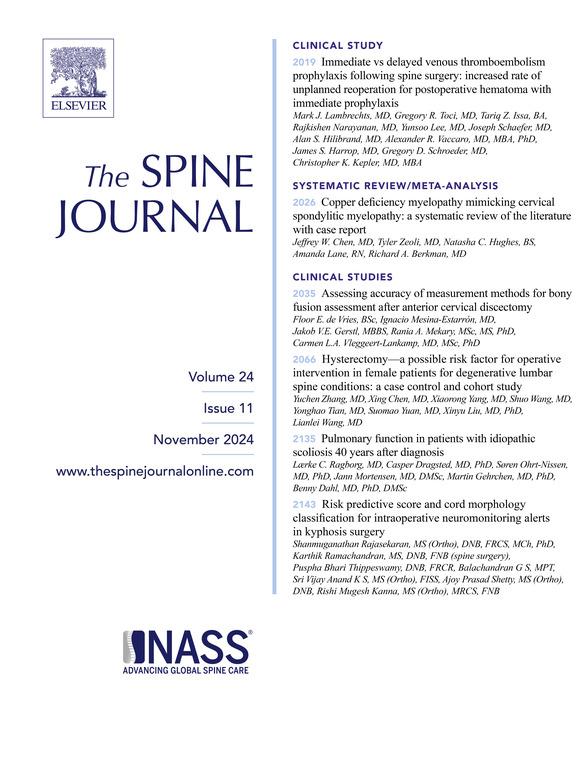18. Cell Saver in adult spinal deformity surgery: helping or hurting?
IF 4.7
1区 医学
Q1 CLINICAL NEUROLOGY
引用次数: 0
Abstract
BACKGROUND CONTEXT
While Cell Saver (CS) is meant to give patients back their own blood products, the quality of said blood products has been called into question.
PURPOSE
In patients undergoing adult spinal deformity (ASD) surgery, we evaluated the impact CS on:1) intraoperative transfusions, 2) postoperative hematocrit, and 3) complications.
STUDY DESIGN/SETTING
Retrospective cohort study
PATIENT SAMPLE
A retrospective cohort study was performed for patients undergoing ASD surgery from 2009-23. Inclusion criteria were: ≥5-level fusion, sagittal/coronal deformity, and ≥2-year follow-up. The primary exposure was use of CS.
OUTCOME MEASURES
Primary outcomes were: 1) intraoperative transfusions, 2) postoperative hematocrit, and 3) overall complications. Secondary outcomes were intraoperative hypotension, defined as total minutes mean arterial pressure (MAP) was <65mmHg, length of stay (LOS), and discharge status.
METHODS
A retrospective cohort study was performed for patients undergoing ASD surgery from 2009-23. Inclusion criteria were: ≥5-level fusion, sagittal/coronal deformity, and ≥2-year follow-up. The primary exposure was use of CS. Primary outcomes were: 1) intraoperative transfusions, 2) postoperative hematocrit, and 3) overall complications. Secondary outcomes were intraoperative hypotension, defined as total minutes mean arterial pressure (MAP) was <65mmHg, length of stay (LOS), and discharge status. Bivariate and multivariable analysis controlling for age, sex, body mass index and operative time were performed.
RESULTS
Of 288 patients undergoing ASD surgery with a mean age of 63±18 years, 209 (73%) used CS. Mean CS given back was 428±404 ml. CS use was associated with a longer operative time (442±149 vs 382±150 minutes, p=0.003) and higher blood loss (1490 vs 765 ml, p<0.001).The CS group paradoxically had higher intraoperative transfusion rates (68% vs 32%, p<0.001) and blood product usage (3±4 vs 1±2 units, p<0.001). Postoperative hematocrit was not different between groups (30±4 vs 30±5, p=0.936). On multivariable regression, CS was independently associated with increased transfusions (OR=2.94, 95%CI: 1.56-5.53, p<0.01) and medical complications (OR=2.72, 95%CI:1.01-7.00, p=0.038). Regarding secondary outcomes, multivariable regression analysis showed that Cell Saver was associated with longer intraoperative hypotension (β=16.8, 95%CI:3.8-29.7, p=0.011) and higher odds of having MAP<65mmHg for ≥90 minutes (OR=3.3, 95%CI:1.1-9.7, p=0.032).
CONCLUSIONS
While controlling for operative time, Cell Saver use in ASD surgery was independently associated with increased intraoperative transfusions, medical complications, and prolonged hypotension without an improvement in postoperative hematocrit levels. Though giving patients back their own blood products appears beneficial, these data question the safety of Cell Saver in ASD surgery.
FDA Device/Drug Status
Cell Saver (Approved for this indication).
18. 成人脊柱畸形手术中的细胞保护:帮助还是伤害?
虽然Cell Saver (CS)的目的是让患者恢复自己的血液制品,但这些血液制品的质量却受到了质疑。目的:在接受成人脊柱畸形(ASD)手术的患者中,我们评估了CS对以下方面的影响:1)术中输血,2)术后红细胞压积,以及3)并发症。研究设计/设置回顾性队列研究患者样本对2009-23年接受ASD手术的患者进行回顾性队列研究。纳入标准为:≥5级融合,矢状/冠状畸形,随访≥2年。主要暴露是使用CS。主要结果为:1)术中输血,2)术后红细胞压积,3)总并发症。次要结局是术中低血压,定义为总分钟平均动脉压(MAP)为65mmHg,住院时间(LOS)和出院状态。方法对2009-23年接受ASD手术的患者进行回顾性队列研究。纳入标准为:≥5级融合,矢状/冠状畸形,随访≥2年。主要暴露是使用CS。主要结局是:1)术中输血,2)术后红细胞压积,3)总并发症。次要结局是术中低血压,定义为总分钟平均动脉压(MAP)为65mmHg,住院时间(LOS)和出院状态。双变量和多变量分析控制年龄、性别、体重指数和手术时间。结果288例平均年龄63±18岁的ASD患者中,209例(73%)采用CS。给予CS的平均为428±404 ml。CS的使用与较长的手术时间(442±149 vs 382±150 min, p=0.003)和较高的出血量(1490 vs 765 ml, p= 0.001)相关。CS组具有较高的术中输血率(68% vs 32%, p<0.001)和血液制品使用量(3±4 vs 1±2单位,p<0.001)。两组术后红细胞压积差异无统计学意义(30±4 vs 30±5,p=0.936)。在多变量回归中,CS与输血量增加(OR=2.94, 95%CI: 1.56-5.53, p<0.01)和医疗并发症(OR=2.72, 95%CI:1.01-7.00, p=0.038)独立相关。关于次要结局,多变量回归分析显示,Cell Saver与术中低血压时间延长(β=16.8, 95%CI:3.8-29.7, p=0.011)和MAP<;65mmHg≥90分钟的较高几率相关(OR=3.3, 95%CI:1.1-9.7, p=0.032)。在控制手术时间的情况下,Cell Saver在ASD手术中的使用与术中输血量增加、医疗并发症和低血压延长独立相关,但未改善术后红细胞压积水平。虽然让患者返回自己的血液制品似乎是有益的,但这些数据质疑Cell Saver在ASD手术中的安全性。FDA设备/药物StatusCell Saver(批准用于此适应症)。
本文章由计算机程序翻译,如有差异,请以英文原文为准。
求助全文
约1分钟内获得全文
求助全文
来源期刊

Spine Journal
医学-临床神经学
CiteScore
8.20
自引率
6.70%
发文量
680
审稿时长
13.1 weeks
期刊介绍:
The Spine Journal, the official journal of the North American Spine Society, is an international and multidisciplinary journal that publishes original, peer-reviewed articles on research and treatment related to the spine and spine care, including basic science and clinical investigations. It is a condition of publication that manuscripts submitted to The Spine Journal have not been published, and will not be simultaneously submitted or published elsewhere. The Spine Journal also publishes major reviews of specific topics by acknowledged authorities, technical notes, teaching editorials, and other special features, Letters to the Editor-in-Chief are encouraged.
 求助内容:
求助内容: 应助结果提醒方式:
应助结果提醒方式:


